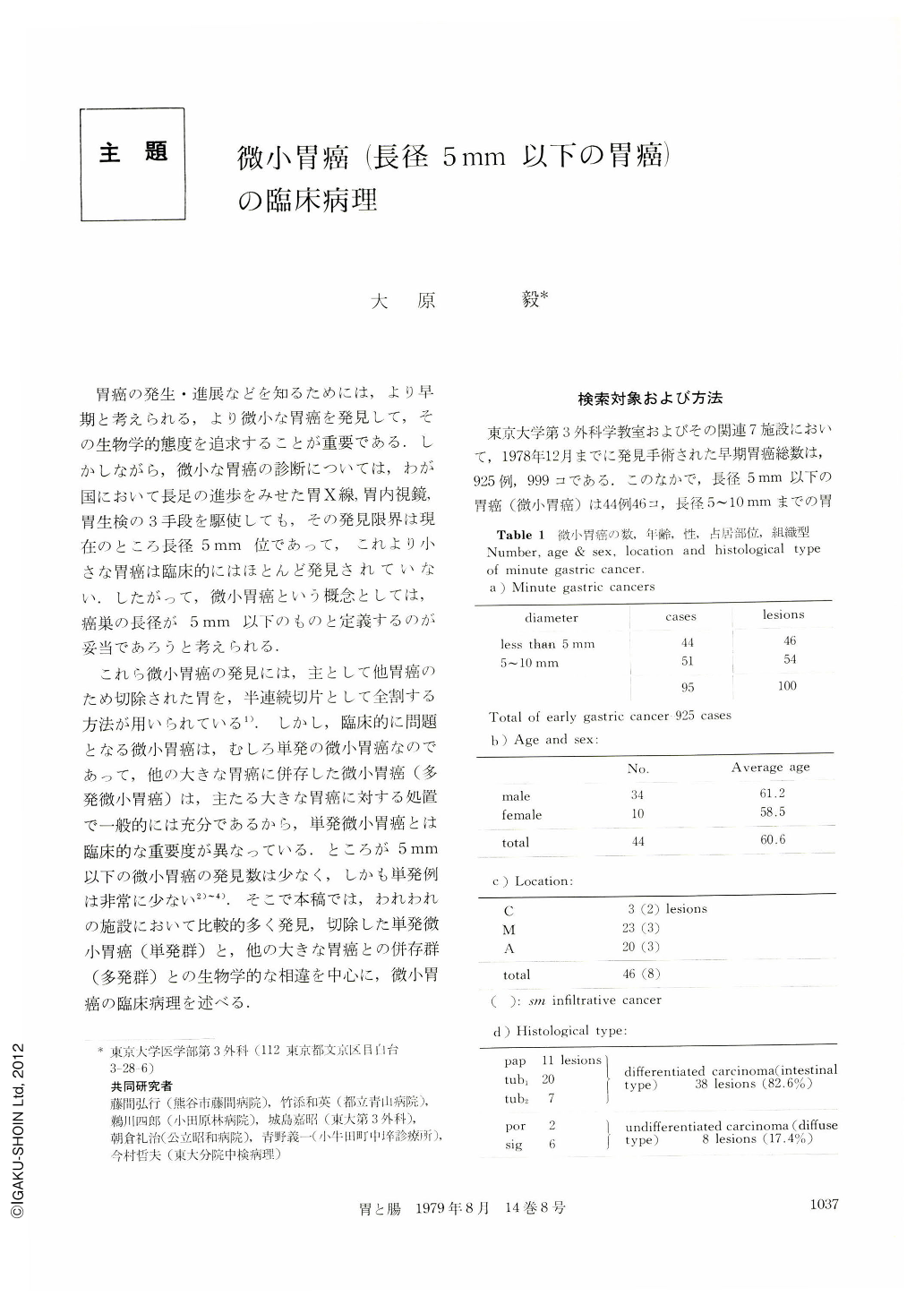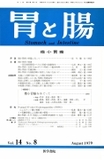Japanese
English
- 有料閲覧
- Abstract 文献概要
- 1ページ目 Look Inside
胃癌の発生・進展などを知るためには,より早期と考えられる,より微小な胃癌を発見して,その生物学的態度を追求することが重要である.しかしながら,微小な胃癌の診断については,わが国において長足の進歩をみせた胃X線,胃内視鏡胃生検の3手段を駆使しても,その発見限界は現在のところ長径5mm位であって,これより小さな胃癌は臨床的にはほとんど発見されていない.したがって,微小胃癌という概念としては,癌巣の長径が5mm以下のものと定義するのが妥当であろうと考えられる,
これら微小胃癌の発見には,主として他胃癌のため切除された胃を,半連続切片として全割する方法が用いられている1).しかし,臨床的に問題となる微小胃癌は,むしろ単発の微小胃癌なのであって,他の大きな胃癌に併存した微小胃癌(多発微小胃癌)は,主たる大きな胃癌に対する処置で一般的には充分であるから,単発微小胃癌とは臨床的な重要度が異なっている.ところが5mm以下の微小胃癌の発見数は少なく,しかも単発例は非常に少ない2)~4).そこで本稿では,われわれの施設において比較的多く発見,切除した単発微小胃癌(単発群)と,他の大きな胃癌との併存群(多発群)との生物学的な相違を中心に,微小胃癌の臨床病理を述べる.
We have made clinico-pathologic study of microcarcinoma of the stomach with an assumption that it be less than 5mm in the longest diameter. Microcarcinoma of the stomach all belonged to early cancer, amounting to 44 cases with 46 lesions. Thirtyfour cases were male and ten were female, and the average age was 60.6 years. The sites of the lesions were three in C (6.5 per cent), 23 in M (50.0 per cent) and 20 in A (43.5 per cent). They were thus predominant in A and M. Even in microcarcinoma more than half of the lesions were macroscopically of depressed type: protruding type in 7 lesions (15.2 per cent); fiat type in all lesions (23.9 per cent) and depressed type in 28 lesions (60.9 per cent). In microcarcinoma less than 3mm in the largest diameter the depressed type fell off sharply. Ulcers within cancer nests were found in six lesions (13.0 per cent).
Histologically, differentiated carcinoma was seen in 38 lesions (82.6 per cent), while undifferentiated one was seen in only 8 lesions (17.4 per cent). Carcinoma of m depth invasion accounted for 38 lesions (82.6 per cent) and that of sm for 8 lesions (17.4per cent). Sm cancer was not seen in lesions less than 3mm in the greatest diameter or in those of protruding type. The frequency of sm invasion according to the degree of differentiation indicated no noticeable difference. Of 38 differentiated carcinoma, sm invasion was seen in 7 lesions (18.4 per cent), and of 8 undifferentiated ones it was seen in one (12.5 per cent).
The development of sm invasion was next studied in lesions with interruption of the muscularis mucosae and in those with no interruption. The former was divided into two groups: the one taking advantage of previous tissue gaplymph follicles and submucosal heterotropic gland) and the other due to ulcers within the cancer nests. The latter seemed to depend on the glandular density in the surrounding non-cancerous mucosa.
Solitary microcarcinoma (14 cases, 31.8 per cent) showed mostly depressed type about 5mm in the largest diameter, and half of them showed sm invasion. This fact is considered of clinically very important significance. Multiple microcarcinoma was seen in 30 cases with a percentage of 68.2

Copyright © 1979, Igaku-Shoin Ltd. All rights reserved.


